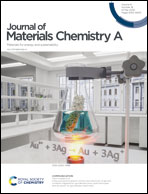P–Fe bond oxygen reduction catalysts toward high-efficiency metal–air batteries and fuel cells†
Abstract
The oxygen reduction activity of carbon-based metal–N catalysts can be effectively regulated by doping with phosphorus (P). However, no attempt has been made to improve the catalyst performance by directly distributing P atoms at the active centers of Fe–N. In this work, P atoms are connected with Fe–Nx moieties in the carbon structure to form P–Fe–Nx bond by the strong electron coupling effect in a novel C–P–Fe–Nx–P–C system (CPFeNPC), verified by extended X-ray absorption fine structure (EXAFS) and X-ray photoelectron spectroscopy (XPS). As a result, it leads to an enhanced oxygen reduction performance with ultrahigh half-wave potentials of 0.923 V and 0.791 V in alkaline and acidic electrolytes, respectively. Significantly, they are far more than that of commercial Pt/C (0.854 V) under alkaline conditions and even almost the same as that of commercial Pt/C (0.807 V) under acidic conditions. Moreover, when adopted as the cathode catalyst, the assembled Zn–air battery (ZAB) and proton-exchange membrane fuel cells (PEMFCs) deliver 1.6-fold and 1.25-fold enhancements in the peak power density compared with that based on commercial Pt/C and conventional Fe–Nx–C catalysts, respectively. The developed catalysts with abundant P-coordinated Fe–Nx sites shine new light on the real application of metal–N–C catalysts in fuel cells.



 Please wait while we load your content...
Please wait while we load your content...